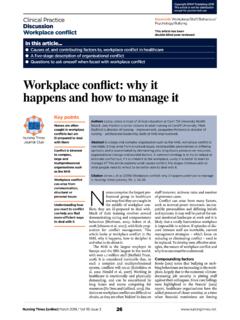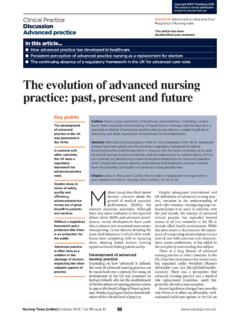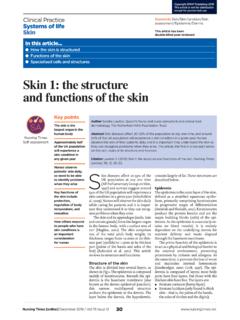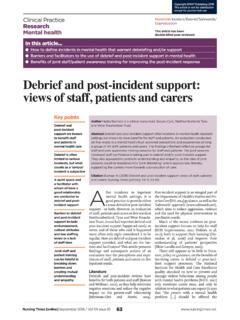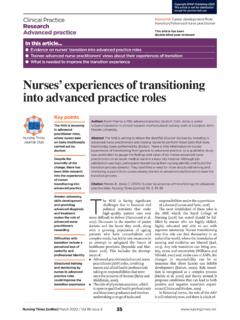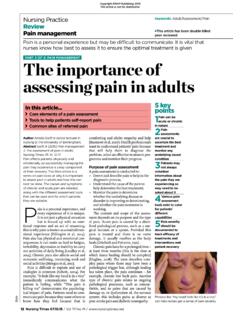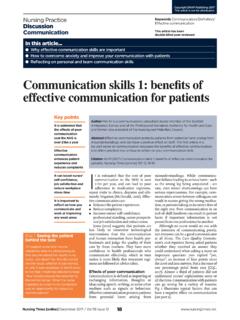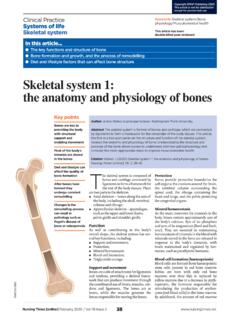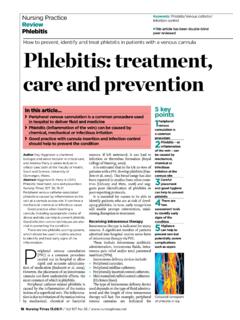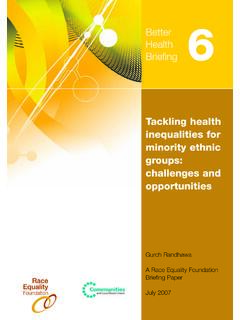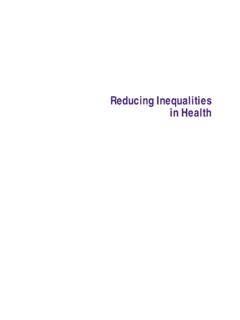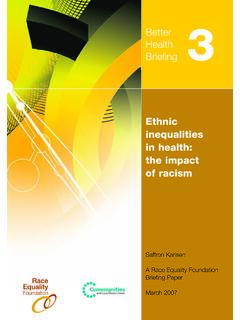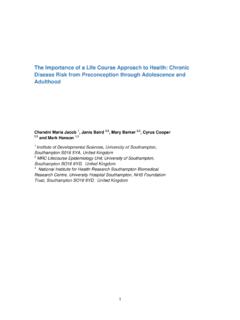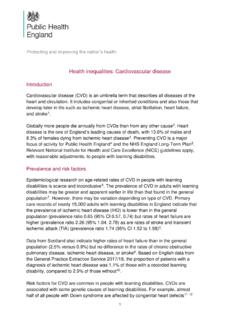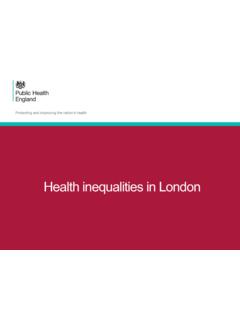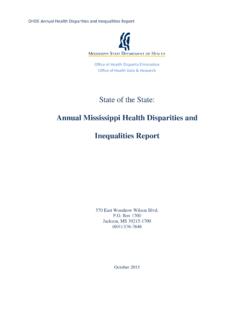Transcription of How gender influences health inequalities - EMAP
1 / Vol 111 No 43 / Nursing Times 21 Keywords: gender /Marxism/Feminism/Sociology This article has been double-blind peer reviewedAuthor David Matthews is lecturer, health and social care, Coleg Llandrillo, Rhos on Matthews D (2015) Sociology in nursing 3: how gender influences health inequalities . Nursing Times; 111: 43, 21-23. This third article in a five-part series on the relationship between sociology and nursing practice discusses the issue of gender as a social determinant. health inequalities between men and women are the result of the interaction between biology and society in terms of how society structures and influences our lives. Men and women have different expectations and roles imposed on them by society and this has a significant impact on a range of socio- economic factors influ-ence health and wellbeing, gender is of particular sig-nificance.
2 While women have lower mor-tality rates than men (Annandale, 2014), they also experience greater morbidity and are over-represented in health statistics (White, 2013). This gives rise to the notion that men die quicker but women are sicker (Bartley, 2004), although recent fig-ures show that the gender gap is closing (Box 1).In addition to overall mortality and mor-bidity, certain health and wellbeing issues are more commonly associated with one gender . For example, dementia, depression and arthritis are more common in women, while men are more prone to lung cancer, cardiovascular disease and suicide (Broom, 2012). The popular biomedical 5 key points 1 Women have lower mortality rates than men, longer life expectancy, greater morbidity and are over-represented in health statistics2 Some health problems are more commonly associated with one gender than the other3 Sociological factors are as important as biology for determining gender -related health inequalities4 Women s natural reproductive function has increasingly been medicalised.
3 Leading to the increased need for healthcare5 Expectations of how men and women should behave are based on social constructs and have an impact on healthinterpretation would argue that variations in health and lifespan can be accounted for by inherent biological differences between men and women. This has led to gender -specific medicine using scientific analysis to explain variations in the physiological differences between the sexes (Annandale, 2014). However, scientific analyses can be criticised for overemphasising differences associated with gender in biological terms there is less difference between male and female than popular belief suggests. Although it influences health , biology does not determine it (Annandale, 2014).
4 health inequalities between the sexes are the result of the interaction between biology and society in terms of how society structures and influences our lives. This article discusses the issue of gender as a social determinant and demonstrates that the way society shapes men s and women s lives has a significant impact on their health . It also examines the extent to which sociological theory can be used to explain health patterns associated with gender . Society and gender There have been a range of theories as to how and why society influences gender inequalities , although there are broad agreements about potential influences . One of these is the gender -specific roles prevalent in society and society s response to these are the main providers of informal care for children, disabled and older people and, some feminists argue, men.
5 The effects of this role can include reduced sleep, less leisure time and increased risk of poverty for women who In this Sociological theory relating to gender -based health patterns How society affects the health of men and women A Marxist-feminist view of women s role in societyThis part of a series on the socioeconomic influences on health and wellbeing discusses how sociology can help to explain health patterns associated with genderHow gender influences health inequalities pArT 3 of 5: Sociology iN NurSiNgNursing PracticeDiscussionSociology 22 Nursing Times / Vol 111 No 43 / PracticeDiscussion are full-time carers. All of these can have serious negative consequences for both physical and mental health .
6 Indeed, it has been suggested that the potential impact of the caring role on mental wellbeing may explain the higher rates of depression in women of childbearing age (Bebbington, 1996). Women s role as carers has been justified as a result of their reproductive function. However, while this is determined by biology, the way it is understood is socially constructed and can affect their experience of health . Women s natural reproductive function has increasingly been medical-ised. For example, mood changes around the time of menstruation are no longer viewed as a natural period of hormonal imbalance resulting in premenstrual ten-sion (PMT), but is now a medical syndrome (premenstrual syndrome) (Morrall, 2009).
7 This medicalisation means women consult doctors and attend hospital more often (White, 2013) than men. Since their bodies have been constructed as a medical issue to a greater degree than men s, women are scrutinised and regu-lated more by medical professionals. This, along with their role as the main providers of care, are significant reasons for their over representation within health statistics. Outside of childbearing age women tend to attend hospital at the same rate as men (Broom, 2012), and when men and women are exposed to the same stressful non- gender specific situations they have broadly the same rates of depression (Nazroo et al, 1997). When variables are no longer a factor, or are controlled, gender -related health inequalities reduce.
8 AlamyGender constructs are such that women tend to be seen as carers, while men are more likely to engage in dangerous activities and internalise problems, taking solace in alcoholmore likely to take part in contact sports, excessive alcohol consumption and dan-gerous driving. As a result males have higher rates of accidental and non-acci-dental injuries (Broom, 2012). Further, it is argued that women have more mental health problems but are more likely to express their feelings and seek sup-port, while men are more likely to inter-nalise anger, turning to substance and alcohol abuse for relief, potentially resulting in drug abuse or even suicide (White, 2013).
9 Ideas of masculinity and femininity influence choice of occupation, and the notable gender divisions within the labour force also have health consequences. For example, manual occupations some of which are potentially dangerous are pre-dominantly performed by men, which exposes them to higher levels of risk. Indeed, of the 350,000 occupational deaths that occurr globally every year, 90 per cent are men (Mathers et al, 2009). Social divisions and gender inequalityAlthough gender -specific roles have sig-nificant health consequences, gender does not operate alone, but interacts with other factors. This can be illustrated by looking at the impact on women of socioeconomic status and men have often been the subjects of studies on the impact of socioeconomic inequality on health , there is no reason to assume that such inequality matters less to women than it does for men.
10 This has the potential to exacerbate health inequalities between men and women, but can lead to inequalities and different experiences of health between people of differing back-grounds within each gender . Many women take career breaks to raise children or care for other family members, while others work part-time to fulfil their caring responsibilities as a result, women tend to have a lower socioeconomic status than men. Although data regarding the links between their socioeconomic status and health is relatively limited (Annandale, 2014), it is possible to surmise that more women are located at the lower end of the socioeconomic scale than men, which would contribute to health inequalities between men and women.
